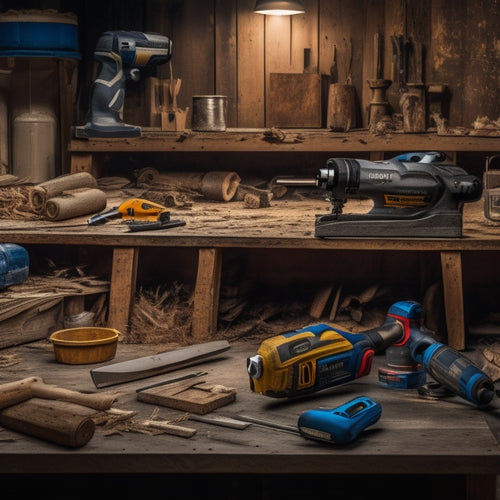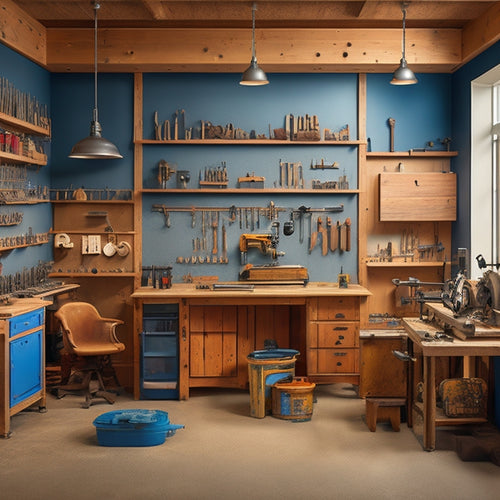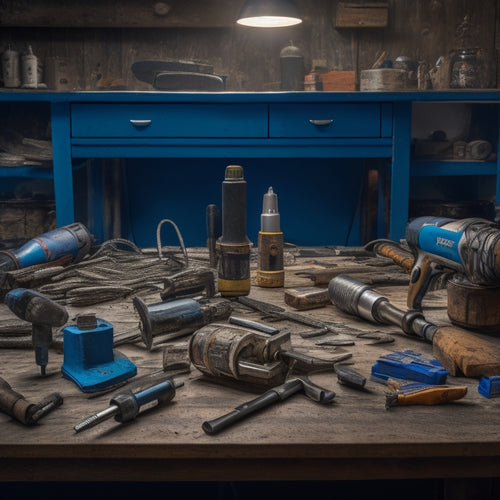
Home Renovation Inspector's Tool Kit Checklist
Share
As a home renovation inspector, you'll need a thorough tool kit to conduct a detailed inspection. Your kit should include measuring and testing tools like tape measures, laser measuring tools, and moisture meters to detect excess moisture. Visual inspection essentials such as lighting and magnification tools, observation tools, and inspection techniques are also vital. Don't forget safety and protection gear like hard hats, safety glasses, and ear protection, as well as material sampling equipment like hand augers and air sampling pumps. With over 25 essential tools and devices, you'll be well-equipped to identify potential issues and create a detailed report - and that's just the start of what you'll need to know to get the job done effectively.
Key Takeaways
• A comprehensive tool kit for home renovation inspectors should include measuring and testing tools, visual inspection essentials, and safety gear.
• Measuring tools like tape measures and laser measuring tools help inspectors calculate areas and volumes for material estimates accurately.
• Visual inspection tools like lighting, magnification tools, and observation skills are crucial for identifying potential issues in a property.
• Inspectors should also be equipped with safety gear like head, eye, hearing, and foot protection to mitigate risks during inspections.
• Specialized devices like thermal imaging cameras, moisture meters, and gas detectors can help inspectors detect specific issues and provide more detailed reports.
Measuring and Testing Tools
Your measuring and testing tools are essential for accurately evaluating a home's condition, and a reliable tape measure is the foundation of this kit.
However, with modern advancements, it's worth considering upgrading to a laser measuring tool. This device uses laser technology to quickly and accurately measure distances, heights, and widths, saving you time and reducing errors.
Additionally, a laser measuring tool can help you calculate areas and volumes, making it easier to estimate materials and costs.
Beyond measuring, you'll need tools to test for specific conditions that can impact a home's integrity. A moisture meter is a must-have for detecting excess moisture in walls, ceilings, and floors.
This handheld device uses electrodes to measure the electrical impedance of a material, indicating the level of moisture present. This information is vital for identifying potential water damage, mold growth, or structural issues.
Visual Inspection Essentials
Incorporate a flashlight, magnifying glass, and binoculars into your visual inspection arsenal to illuminate dark spaces, scrutinize minute details, and survey hard-to-reach areas. These essentials will enhance your visual inspection techniques, allowing you to uncover potential issues that might be hidden from the naked eye.
A flashlight will help you navigate through dimly lit crawlspaces, attics, or basements, while a magnifying glass will enable you to examine small cracks, corrosion, or other defects up close. Binoculars will come in handy when inspecting rooflines, chimneys, or other elevated areas.
Developing strong observation skills is vital for a home renovation inspector. You'll need to be meticulous in your observation, taking note of even the smallest details that could indicate a larger problem.
By combining these visual inspection essentials with your observation skills, you'll be able to identify potential issues before they become major problems. Remember, a thorough visual inspection is the foundation of a successful home renovation project.
Safety and Protection Gear
As you prepare for a home renovation inspection, you'll need to prioritize your safety and protection above all else.
You'll be entering a potentially hazardous environment, and it's vital that you're equipped with the right gear to prevent injuries.
Your safety and protection gear should include essential items like hard hats and helmets, eye and ear protection, and steel-toed boots.
Hard Hats and Helmets
You'll need a reliable hard hat or helmet to protect your head from falling objects, debris, and electrical hazards on the renovation site.
When selecting a hard hat, verify it meets the Occupational Safety and Health Administration (OSHA) hard hat standards and helmet regulations. Look for a hat with a certification label from a reputable testing organization, such as the American National Standards Institute (ANSI) or the Snell Memorial Foundation.
Choose a hard hat that fits snugly and comfortably, with an adjustable suspension system to absorb impact. The hat should also have a chin strap to keep it securely in place.
Consider a hard hat with a built-in visor to protect your face from debris. Don't compromise on quality – a good hard hat can mean the difference between safety and serious injury.
Remember, a hard hat isn't a one-size-fits-all solution; it's crucial to choose the right size and type for your specific needs.
Eye and Ear Protection
Protect your eyes and ears from hazardous materials, power tools, and other on-site dangers by wearing appropriate safety gear, including safety glasses, goggles, or face shields, and earplugs or earmuffs.
When it comes to eye safety, you'll want to choose the right type of protection for the task at hand. For example, safety glasses with impact-resistant lenses are ideal for general site work, while goggles or face shields provide additional protection for tasks involving chemical splashes or flying debris.
Don't forget about hearing conservation - prolonged exposure to loud noises can cause permanent damage. Earplugs or earmuffs can reduce noise levels and prevent hearing loss. When selecting ear protection, consider the noise reduction rating (NRR) and choose a product that meets the specific needs of your work environment.
Steel-Toed Boots
Your feet are constantly exposed to heavy objects, sharp edges, and slippery surfaces on the job site, making steel-toed boots an essential component of your safety and protection gear. Steel-toed boots provide a barrier between your feet and potential hazards, reducing the risk of injury. The steel-toed benefits are undeniable—they protect your toes from crushing and puncture wounds and provide additional support and stability on uneven terrain.
When choosing steel-toed boots, look for ones that meet the American Society for Testing and Materials (ASTM) standards for impact and compression resistance. Additionally, consider boots with slip-resistant soles to reduce the risk of falls.
To guarantee your boots remain effective, perform regular boot maintenance. Check the soles for wear and tear, and clean the boots regularly to prevent the buildup of debris. Store your boots in a dry, cool place to prevent damage from extreme temperatures or moisture.
Material Sampling Equipment
When conducting a home renovation inspection, material sampling equipment is essential for collecting and analyzing physical evidence of potential defects or hazards. As an inspector, you'll need to collect samples of various materials to determine their composition, quality, and performance. This equipment helps you identify potential issues, such as asbestos, lead, or structural weaknesses, guaranteeing the safety and integrity of the renovated space.
| Material Sampling Equipment | Description | Purpose |
|---|---|---|
| Hand auger | A manual drilling tool for collecting soil samples | Soil composition analysis |
| Material scraper | A tool for scraping and collecting surface materials | Identifying surface defects or contaminants |
| Air sampling pump | A device for collecting air samples | Analyzing indoor air quality |
| Infrared thermometer | A device for measuring surface temperatures | Detecting thermal anomalies or energy losses |
| Tape lift sampler | A tool for collecting surface samples using adhesive tape | Analyzing surface materials and defects |
Remember to calibrate your equipment regularly and follow established material analysis techniques to guarantee accurate results. By including these essential tools in your toolkit, you'll be well-equipped to collect and analyze material samples, providing a thorough and accurate inspection report.
Documenting and Reporting Tools
As you prepare to document and report on your home renovation inspection findings, you'll need a range of tools to efficiently gather and organize your data.
You'll want to have report writing templates on hand to streamline your writing process, as well as digital photo storage solutions to keep your visual evidence tidy.
Additionally, a defect log system will help you track and categorize any issues you uncover during the inspection.
Report Writing Templates
You'll need a standardized report writing template to efficiently document and communicate your findings to clients, contractors, and other stakeholders. A well-structured template guarantees consistency in report formatting, making it easier for readers to navigate and understand the content.
It's crucial to customize your template to fit your specific needs, incorporating sections for project details, observations, recommendations, and conclusions. Consider including tables, charts, and graphs to visualize data and highlight key findings.
When selecting a template, look for one that allows for flexibility in report formatting, enabling you to tailor the layout and design to your preferences. Additionally, choose a template that permits customization, enabling you to add or remove sections as needed.
This will guarantee that your reports are professional, thorough, and easy to understand. By using a standardized report writing template, you'll save time and effort, while also ensuring that your reports meet the needs of your clients and stakeholders.
Digital Photo Storage
To supplement your written reports, a digital photo storage system is necessary for organizing and storing visual evidence of property conditions, defects, and completed repairs. This system allows you to efficiently categorize and retrieve photos, making it easier to document and report on your findings.
You'll want to take into account a cloud storage solution, which provides secure, remote access to your photos from anywhere. This eliminates the need for physical storage devices and guarantees your files are protected in case of loss or damage.
When choosing a digital photo storage system, look for features that enable easy organizing, such as tagging, categorization, and search functionality. This will save you time when searching for specific photos or creating reports.
Additionally, think about a system that allows you to add notes or descriptions to individual photos, enabling you to provide context and clarify any defects or issues.
Defect Log Systems
Implement a defect log system that systematically catalogs and tracks property defects, allowing you to efficiently document and report on issues, from initial identification to final resolution.
This system should include a standardized defect classification method, enabling you to categorize defects by type, severity, and location. This will facilitate quick identification of patterns and trends, helping you pinpoint areas that require immediate attention.
To streamline the process, consider utilizing defect tracking software that offers features such as automated reporting, customizable templates, and real-time collaboration tools. This will enable you to easily generate thorough reports, complete with photographic evidence and detailed descriptions, which can be shared with contractors, clients, or other stakeholders.
By implementing a robust defect log system, you'll be able to track progress, monitor resolutions, and maintain a clear record of all defects, ensuring that no issue falls through the cracks.
With this system in place, you'll have the freedom to focus on what matters most – delivering high-quality renovation projects that meet your clients' expectations.
Specialized Inspection Devices
Your home renovation inspector's tool kit should include a range of specialized inspection devices designed to detect and diagnose specific issues in various building components and systems. These devices will help you identify problems that mightn't be visible to the naked eye, giving you a more thorough understanding of the property's condition.
Thermal imaging cameras, for instance, can detect temperature anomalies that may indicate energy losses, moisture intrusion, or electrical issues. You'll be able to identify areas where insulation is lacking, pipes are leaking, or electrical components are overheating.
Moisture meters, on the other hand, will help you detect excessive moisture levels in building materials, which can lead to mold growth, structural damage, or pest infestations.
Other specialized devices you should consider include acoustic sensors for detecting termite activity, gas detectors for identifying hazardous gas leaks, and manometers for measuring pressure differentials in HVAC systems.
Frequently Asked Questions
How Often Should I Update My Home Renovation Inspector's Tool Kit?
You should regularly assess your tool kit's condition to guarantee it remains effective and efficient.
Aim for tool maintenance every 3-6 months to identify worn or damaged items.
Additionally, consider seasonal updates to adapt to changing project demands.
For instance, you may need to swap out winter gear for summer tools or add specialized equipment for specific projects.
What Certification Is Required to Become a Home Renovation Inspector?
As you venture into the world of home renovation inspection, you're wondering what certification is required to become a pro.
The answer lies in the certification process, which varies by state and locality. Typically, you'll need to meet inspector qualifications, such as completing a training program, passing a licensing exam, and gaining field experience.
In the US, the American Society of Home Inspectors (ASHI) and the International Association of Certified Home Inspectors (InterNACHI) offer recognized certifications.
Can I Use Borrowed Tools for a Home Renovation Inspection?
When conducting a home renovation inspection, you'll need to take into account tool ownership and borrowing etiquette.
While it's tempting to borrow tools from friends or colleagues, it's essential to make certain you have the necessary equipment to do the job accurately and efficiently.
Relying on borrowed tools can lead to inconsistencies and compromise your professional reputation.
It's best to invest in your own tools, guaranteeing you have control over their quality, calibration, and maintenance.
How Do I Handle a Difficult or Uncooperative Homeowner?
When dealing with a difficult or uncooperative homeowner, you'll need to employ effective conflict resolution and communication strategies.
Stay calm, composed, and objective, focusing on the inspection's purpose and scope.
Clearly explain your process and findings, using 'I' statements to avoid blame.
If tensions rise, pivot to active listening, acknowledging their concerns and validating their emotions.
What Is the Average Cost of a Home Renovation Inspection Tool Kit?
Crafting a detailed cost breakdown for your inspection tool kit, you'll find that quality matters.
Investing in top-tier tools can save you time and hassle in the long run.
On average, a high-quality tool kit can cost between $5,000 to $10,000, depending on the specific tools and technology included.
Be prepared to shell out more for advanced features, but rest assured, it'll be worth it for the freedom to conduct thorough inspections with confidence.
Conclusion
As you begin your home renovation inspection, remember that having the right tools is just the tip of the iceberg.
A thorough inspector must also possess the knowledge and expertise to interpret the data and identify potential issues.
With this detailed tool kit checklist, you'll be well-equipped to dig deeper and uncover the hidden gems - or pitfalls - that lie beneath the surface.
Now, it's time to roll up your sleeves and get down to business!
Related Posts
-

10 Best Power Tools to Buy for Home Renovation
To tackle your home renovation project efficiently, you'll need the right power tools for the job. A cordless drill f...
-

Renovation Tool Checklist for Smooth Finishes
When tackling a renovation project that requires a smooth finish, you'll need a thorough tool checklist to guarantee ...
-

What to Look for in Pneumatic Renovation Tools
When selecting pneumatic renovation tools, you'll want to take into account several key factors to guarantee optimal ...


